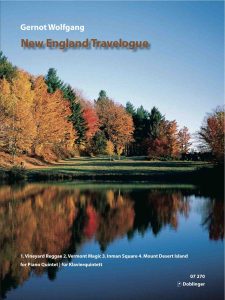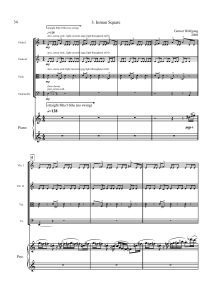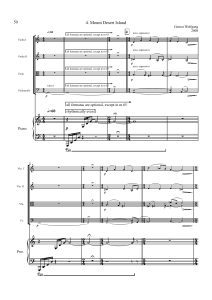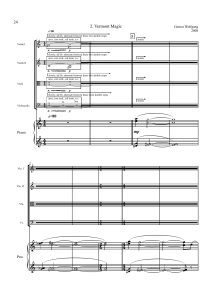NEW ENGLAND TRAVELOGUE (2008)
for 2 violins, viola, violoncello & piano
Doblinger Music Publishers (catalog # 07 270)
07/27/2009 at the Old Whaling Church in Edgartown, MA by the Eclipse Quartet and Delores Stevens - piano
Martha's Vineyard Chamber Music Society
Gernot Wolfgang, PASSING THROUGH, Albany Records CD TROY 1624
_____________________________________________________
DOWNLOAD PROGRAM NOTES (English)
DOWNLOAD PROGRAM NOTES (German)



(click on images of excerpts to enlarge)
Stream on Spotify (album link, tracks 9-12)
Stream on YouTube:
1. Vineyard Reggae
2. Vermont Magic
3. Inman Square
4. Mount Desert Island
Watch a video of a live performance by members of the Kaleidoscope Chamber Orchestra
More information about the recording of New England Travelogue
on the GRAMMY®nominated album PASSING THROUGH
_____________________________________________________
Purchase the sheet music for New England Travelogue at:
Theodore Front Musical Literature, Inc.
sheetmusicplus.com
Reviews:
“Another masterpiece appears in the form of his piano quintet, “New England Travelogue”. Once again, we are treated to the most engaging variety of mood and colorful orchestration, with the addition of the piano. And I must make special mention of the fabulous piano playing of Joanne Pearce Martin, who impressed me so greatly in Volume 4 as well. It’s not that it’s a difficult piece to play; she just makes such music out of it – wonderfully singing, helped by the clear, resonant recording acoustic. And the playing of the Eclipse Quartet is beyond reproach.”
David Rowe, Classical CD Reviews
“Scored for piano and string quartet, New England Travelogue (2009) was inspired by the composer’s time in New England in the 1980s. The initial “Vineyard Reggae” paints a picture of a party-like scene in Edgartown, on Martha’s Vineyard, before withdrawing to that time of night, post-party and awaiting the dawn. The piece is very skillfully written: listen to the way the piano creeps in against pizzicato strings around the five-minute mark for a particularly delicious example of this. The second panel, “Vermont Magic,” refers to Christmas time in Northeast Kingdom, Vermont. The glassy depiction of moonlight, owing something to Bartókian night music, is gripping and wonderfully performed: the players’ control of their instruments is nothing short of miraculous, and it is the sheer sense of chamber music at its finest that enables the music to have an internal glow. The jazz clubs of “Inman Square” (Massachusetts) inspired the musical language of the third panel, as well as the hustle and bustle around these clubs. In contrast, the slow beauty of the final “Mount Desert Island” seeks to depict the calm of the inland lakes of Maine’s Arcadia National Park. It makes for a most satisfying finale, resonating on in the listener’s mind most evocatively.”
Colin Clarke, Fanfare
“Vineyard Reggae … is syncopated and very catchy, with a good bit of intricate interplay between the two violins. The latter part of the movement which features sustained chords over pizzicato in the four strings is also particularly effective. Vermont Magic begins similarly, at least as far as the chords in the piano go, but here, the strings are quite static—almost to the degree that they are in The Unanswered Question. The effect, though, is very different from anything in Ives. It reminds me more of Messiaen in an alternate universe. The composer here meant to portray Vermont at Christmastime, with snow dust blowing out of trees. The movement effectively portrays such imagery throughout, largely through sonorities in the quartet played senza vibrato. Inman Square is a sort of jazzy New England hoe-down, and hearkens to the jazz scene in Cambridge. Mount Desert Island depicts the Arcadia National Park in Maine, which is possessed of a number of quiet inland lakes, despite being on an island. My wife and I visited this very park a couple years ago, and I can attest that Wolfgang has herein captured the splendor of the place, with its majestic vistas from Cadillac Mountain, the highest point along the North Atlantic seaboard, and the point where the sunrise of each new day is first visible anywhere in the U.S.”
David DeBoor Canfield, Fanfare
“Each of the movements find their moods and rhythms in the worlds of jazz and pop with a touch of Impressionist tone painting. “Vineyard Reggae”, inspired by a busy evening on Martha’s Vineyard, introduces an intoxicating, repetitive bass figure (trust me, it will stick with you) over which the composer floats the sights and sounds of the “tourists in a vacation mood.” The parties end, and Martha’s Vineyard is all misty and silent… or is it? Impressive and expressive performances from the whole ensemble contribute impressively to this complex little piece. “Vermont Magic” is a wistful reminiscence of a Christmas-time drive in the snowy, dark forests of Vermont. Individual string solos express their wonder at the landscape and then move on, leaving the snowy vista behind in this frosty, awe inspiring tone poem. “Inman Square” is a short jazzy interlude leading to the glassy and threadbare “Mount Desert Island,” which evokes the quiet majesty and smooth waters of the many inland lakes on the island. New England Travelogue is a most impressive and stunningly performed work that would not be out of place in any piano quintet program.”
Don Clark, icareifyoulisten.com
“The opening movement, Vineyard Reggae, has an appealing rhythmic figure from piano and lower strings under violins circling round, before moving to a highly effective piano unison melody with pizzicato strings. Vermont Magic starts with slow bluesy chords, and then individual instrumental solos which develop into something rather powerful. Inman Square is all rhythmic strings and jazzy piano, whilst the last movement Mount Desert Island is slow with almost consonant harmony.”
Robert Hugill, planethugill.com
“Mount Desert Island: The quiet beauty of Maine’s Mount Desert Island translated musically into complete stillness … harmonically stunning.”
Rafael de Acha, rafaelmusicnotes.com
“The first movement has interesting rhythmic undercurrents that have a slight jazz feel, but the music is perceived more within a semi Stravinsky-Bartok like style (or perhaps an extension of some of Jerry Goldsmith’s adaptation of this interplay of rhythm and wit). The tranquility of the second movement has an atmosphere of stillness with piano harmonies outlining a primary idea at first as strings create a pedal point. The third movement picks up the energy as things move us forward through the ensemble and segues into an almost Americana introspective finale. While the energetic sections of the work are thrilling, the more reflective moments offer some of the piece’s most shining and deeply personal moments.”
Steven A. Kennedy, Cinemusical
“Being attracted to visual images is another aspect of Wolfgang’s imagination, and New England Travelogue from 2008, scored for piano quintet, is Ivesian in its spirit of place: It moves from Inman Square in Cambridge, famous in the 1980s for having two jazz clubs across the street from each other, to the Vermont woods and Martha’s Vineyard. Especially effective is the first movement, “Vineyard Reggae,” where upbeat walking music begins at twilight, gradually becoming more spare and relaxed, until night has passed and the dawn is greeted by a tapering into silence before the first twinkle of sunlight caps the coda with a brief curlicue.”
Huntley Dent, Fanfare
“It is hard to imagine any contemporary composer writing music about New England without some nod to Ives, and there is indeed some sense of his gruff beauty in sections of this grouping, especially the music evoking Mount Desert Island and Vermont. Ives, it can be fairly certain, was not familiar with reggae music, but if he was, he may have produced something like the delightfully joyous “Vineyard Reggae,” a riff on a festive summer evening at Martha’s Vineyard.”
Peter Burwasser, Fanfare
“Gernot Wolfgang’s inspiration for this composition were New England’s picturesque natural settings as well as its urban melting pots. His travelogue in form of a piano quintet, written in a tonal language somewhere between Jazz and moderate Modernism, indicates that the Austrian-born resident of Los Angeles also knows his way around film music.”
Manuel Roesler, Ensemble (Germany)

